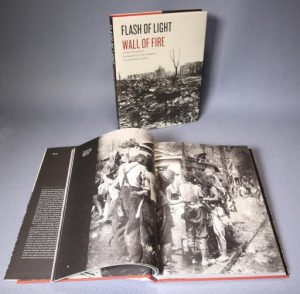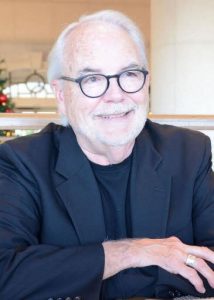U.S. museum in Texas publishes collection of photos taken in 1945 that show reality of atomic bombings unknown to Americans
Oct. 5, 2020
by Michiko Tanaka, Staff Writer
The Briscoe Center for American History, a museum attached to the University of Texas at Austin in the United States, has published a collection of photographs in this 75th anniversary year that conveys the horrific conditions in Hiroshima and Nagasaki at the time of the atomic bombings of the two cities. All the photos in the collection, including many never before seen by the American public, were taken by Japanese people. A museum representative said, “These photographs provide stunning and revelatory visual evidence of what happens when nuclear weapons are used against human beings. It could be a beneficial tool as a warning for the future.” An exhibit of the book’s photos is also scheduled to take place at the museum.
The title of the photo collection is Flash of Light, Wall of Fire. It includes a total of 118 photos taken in Hiroshima and Nagasaki during the period from August 6, 1945, the date when the atomic bomb was dropped on Hiroshima, until the end of that year.
The photos were taken by 16 photographers and others who belonged to the Japanese military and members of a special team with the former Ministry of Education that had been tasked with investigating the devastation caused by the atomic bombings. For use in the collection, the museum selected photos that capture details of the reality of the devastation, such as wounded citizens lying down at a first-aid station, a woman receiving treatment for her burns, and images of the devastated cities themselves.
Don Carleton, 73, executive director of the museum, drew up the plans for publication. Mr. Carleton explained he had been inspired by a photo collection released in 2015 by the Anti-Nuclear Photographer’s Movement (ANPM; with offices in Asaka City, Saitama Prefecture), a Japanese group working on the collection and preservation of photos related to the atomic bombings. “The dominant visual impression of nuclear war in American culture is the mushroom cloud — that is the view from a distance. The great strength of the photographs taken from the ground level is that it forces us to comprehend the effects of nuclear war,” said Mr. Carleton. Against a backdrop of a heightened sense of crisis over escalation of tensions among nuclear powers, he started making preparations in 2018 toward publication of the collection.
Nevertheless, careful review was necessary before the collection could be commercialized. In the United States, a deep-seated opinion persists in which use of the atomic bombs are believed to have helped hasten the end of World War II. In fact, Mr. Carleton’s father belonged to the U.S. Army Air Force during the war and underwent training to invade Japan’s mainland. His father believed his life had been saved because of the atomic bombings.
“I had no interest in our center engaging in any effort to refight the war (World War II in the Pacific), or involving itself in the endless debate over the decision to drop the atomic bombs or assign war guilt,” Mr. Carleton said. “Japanese photographers took these photographs to document the devastation while some of them seriously injured themselves and tried to protect the photos from confiscation after the war at all costs. I would like our users to watch the photos and form their own interpretations using their critical thinking skills based on the evidence they find at the center.” The entire set of photographic data will be released and made available at the museum for students and researchers.
The 255-page photo collection, published on August 6, sells for $50.00. It is available for purchase on the University of Texas Press site and major U.S. online booksellers. After a New York Times’ report on the book, a flood of orders came in for the initial print run of 1,200 copies, with a decision already made to print an additional 1,700 copies. The photo exhibit will take place in or after February of next year, depending on the situation surrounding the coronavirus pandemic.
(Originally published on October 5, 2020)
The Briscoe Center for American History, a museum attached to the University of Texas at Austin in the United States, has published a collection of photographs in this 75th anniversary year that conveys the horrific conditions in Hiroshima and Nagasaki at the time of the atomic bombings of the two cities. All the photos in the collection, including many never before seen by the American public, were taken by Japanese people. A museum representative said, “These photographs provide stunning and revelatory visual evidence of what happens when nuclear weapons are used against human beings. It could be a beneficial tool as a warning for the future.” An exhibit of the book’s photos is also scheduled to take place at the museum.
The title of the photo collection is Flash of Light, Wall of Fire. It includes a total of 118 photos taken in Hiroshima and Nagasaki during the period from August 6, 1945, the date when the atomic bomb was dropped on Hiroshima, until the end of that year.
The photos were taken by 16 photographers and others who belonged to the Japanese military and members of a special team with the former Ministry of Education that had been tasked with investigating the devastation caused by the atomic bombings. For use in the collection, the museum selected photos that capture details of the reality of the devastation, such as wounded citizens lying down at a first-aid station, a woman receiving treatment for her burns, and images of the devastated cities themselves.
Don Carleton, 73, executive director of the museum, drew up the plans for publication. Mr. Carleton explained he had been inspired by a photo collection released in 2015 by the Anti-Nuclear Photographer’s Movement (ANPM; with offices in Asaka City, Saitama Prefecture), a Japanese group working on the collection and preservation of photos related to the atomic bombings. “The dominant visual impression of nuclear war in American culture is the mushroom cloud — that is the view from a distance. The great strength of the photographs taken from the ground level is that it forces us to comprehend the effects of nuclear war,” said Mr. Carleton. Against a backdrop of a heightened sense of crisis over escalation of tensions among nuclear powers, he started making preparations in 2018 toward publication of the collection.
Nevertheless, careful review was necessary before the collection could be commercialized. In the United States, a deep-seated opinion persists in which use of the atomic bombs are believed to have helped hasten the end of World War II. In fact, Mr. Carleton’s father belonged to the U.S. Army Air Force during the war and underwent training to invade Japan’s mainland. His father believed his life had been saved because of the atomic bombings.
“I had no interest in our center engaging in any effort to refight the war (World War II in the Pacific), or involving itself in the endless debate over the decision to drop the atomic bombs or assign war guilt,” Mr. Carleton said. “Japanese photographers took these photographs to document the devastation while some of them seriously injured themselves and tried to protect the photos from confiscation after the war at all costs. I would like our users to watch the photos and form their own interpretations using their critical thinking skills based on the evidence they find at the center.” The entire set of photographic data will be released and made available at the museum for students and researchers.
The 255-page photo collection, published on August 6, sells for $50.00. It is available for purchase on the University of Texas Press site and major U.S. online booksellers. After a New York Times’ report on the book, a flood of orders came in for the initial print run of 1,200 copies, with a decision already made to print an additional 1,700 copies. The photo exhibit will take place in or after February of next year, depending on the situation surrounding the coronavirus pandemic.
(Originally published on October 5, 2020)









